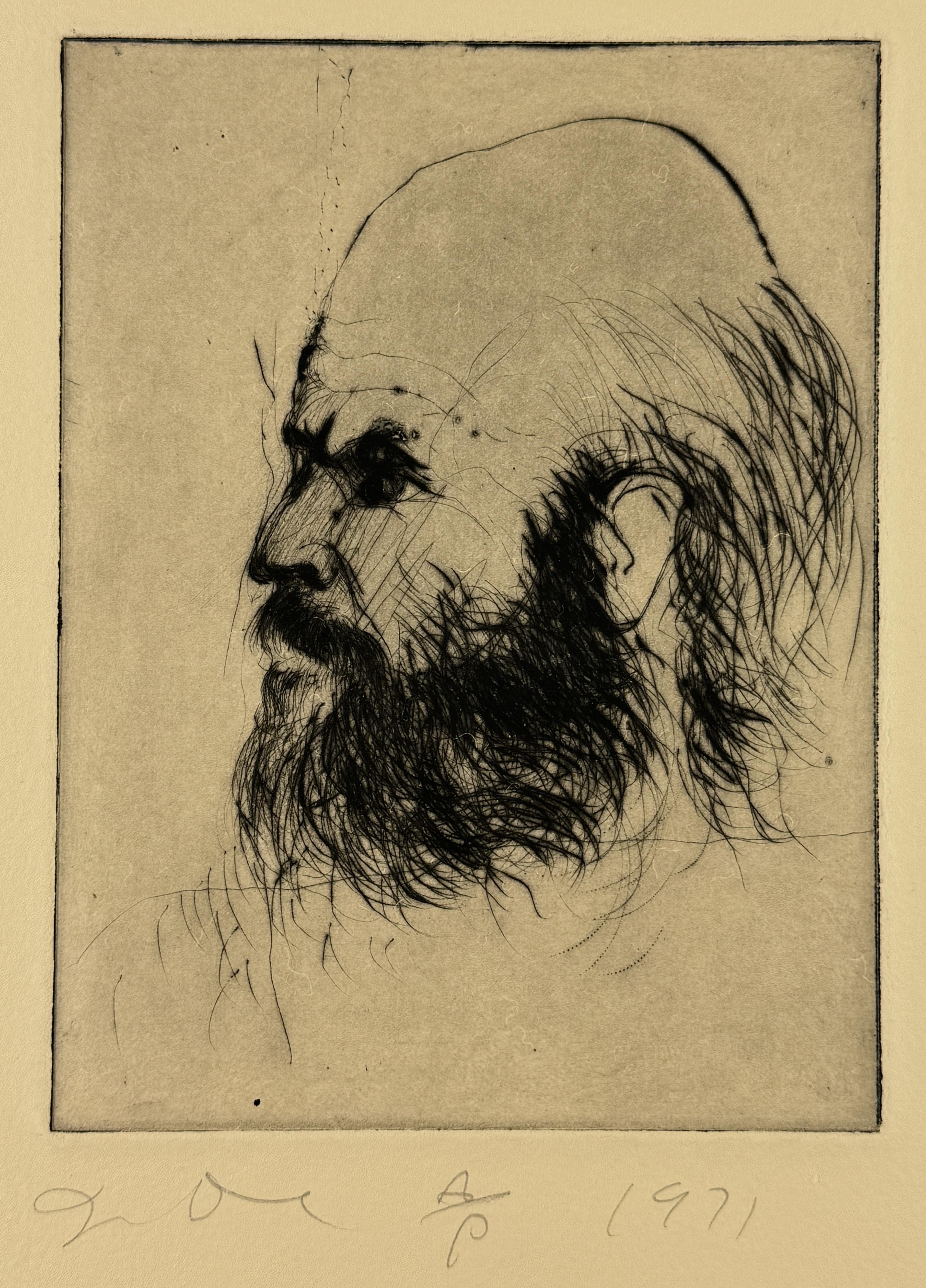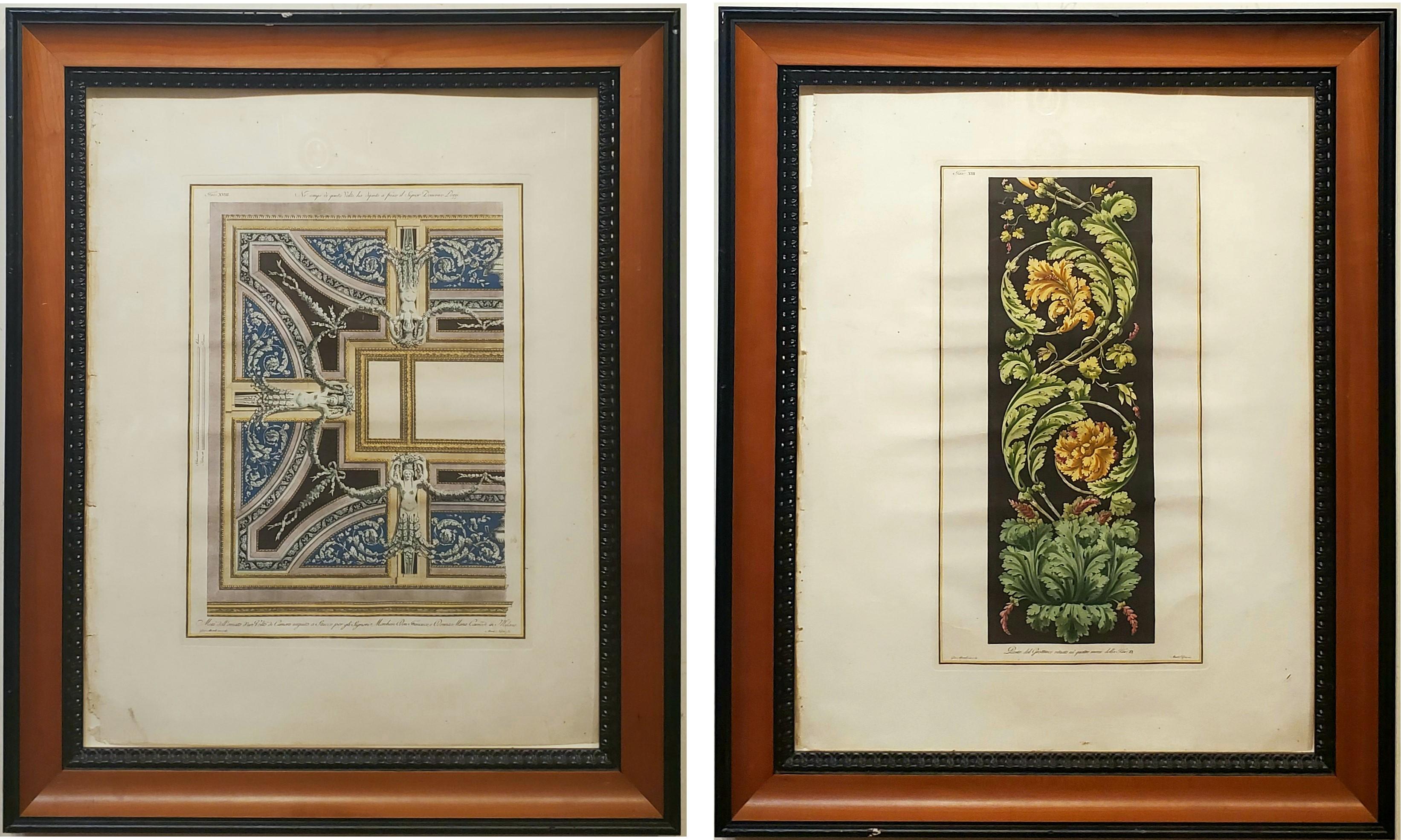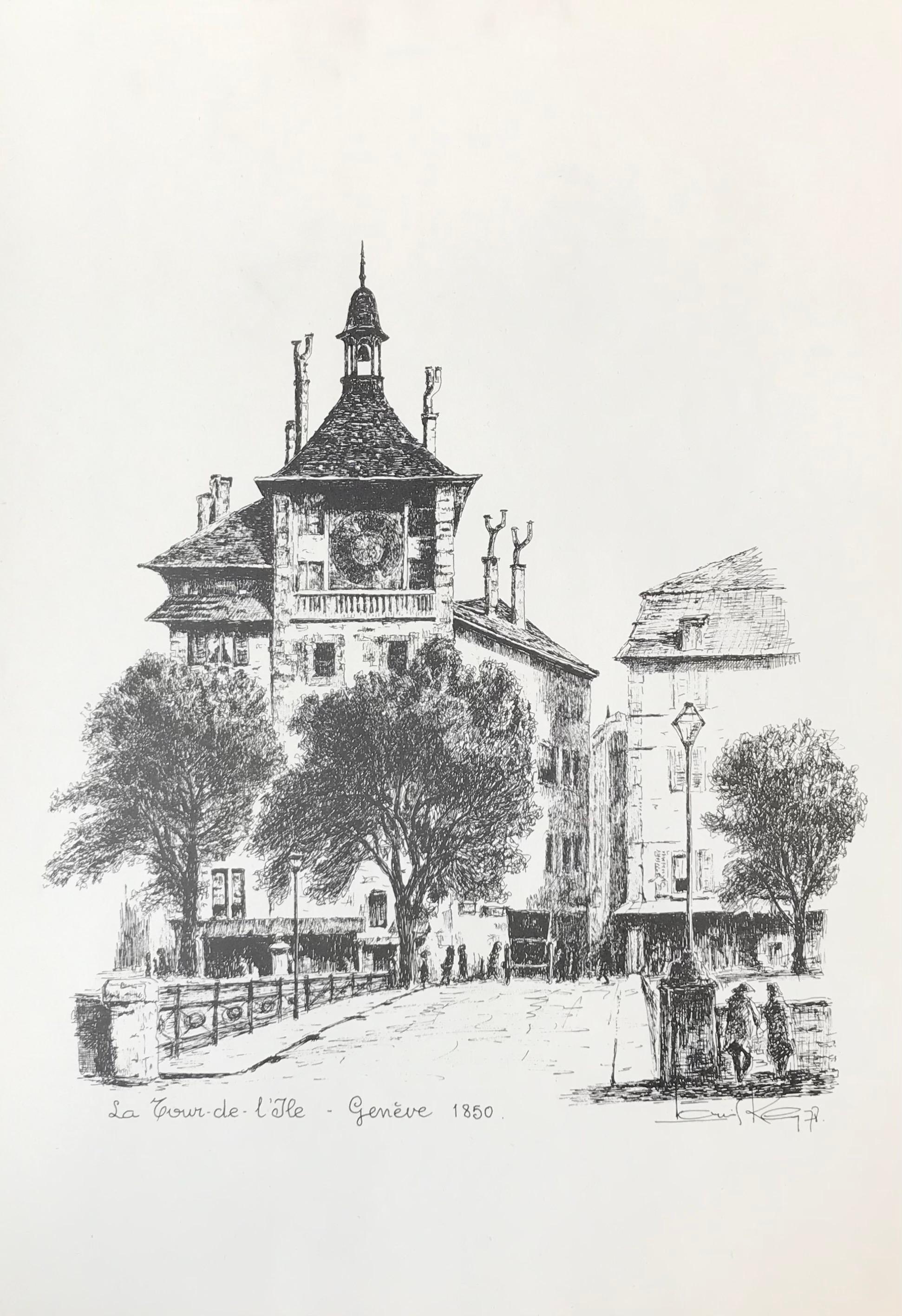Items Similar to Architectura Curiosa Nova, Chalice Garden Fountain
Want more images or videos?
Request additional images or videos from the seller
1 of 3
Georg Andreas BöcklerArchitectura Curiosa Nova, Chalice Garden Fountain1664
1664
About the Item
George Andreas Böckler, 'Chalice Garden Fountain', antique copperplate engraving, 1664, from the book 'Architectura Curiosa Nova'. A fine, richly inked impression, on antique cream laid paper; the full sheet as published, in good condition. Image size 10 1/2 x 7 inches; sheet size 13 x 8 1/2 inches. Matted to museum standards, unframed.
ABOUT THE ARTIST
Georg Andreas Böckler (c. 1617-1687) was a German architect, engineer, and author. He was the architect of the city of Nuremberg and specialized in hydraulic architecture. Architectura Curiosa Nova was his main opus, a four-part work in one volume, published in 1664. Illustrated with 200 engravings, the decorative plates of the first three parts show the theory and application of hydrodynamics for fountains, water-jets, spray-patterns, garden fountains, and well heads; with elaborate and often fanciful designs for free-standing fountains. The fourth part includes designs for grottoes, garden pavilions, and architectural designs, including views of European palaces.
- Creator:Georg Andreas Böckler (1617 - 1687, German)
- Creation Year:1664
- Dimensions:Height: 10.5 in (26.67 cm)Width: 7 in (17.78 cm)
- Medium:
- Movement & Style:
- Period:1660-1669
- Condition:
- Gallery Location:Myrtle Beach, SC
- Reference Number:1stDibs: LU53235238682
About the Seller
5.0
Recognized Seller
These prestigious sellers are industry leaders and represent the highest echelon for item quality and design.
Platinum Seller
These expertly vetted sellers are 1stDibs' most experienced sellers and are rated highest by our customers.
Established in 1995
1stDibs seller since 2016
254 sales on 1stDibs
Typical response time: 2 hours
Associations
International Fine Print Dealers Association
- ShippingRetrieving quote...Ships From: Myrtle Beach, SC
- Return PolicyA return for this item may be initiated within 7 days of delivery.
More From This SellerView All
- ExploratorLocated in Myrtle Beach, SCGiovanni Domenico Campiglia, 'Explorator', engraving, 1734, edition unknown, scarce. Signed 'Dom. Campiglia del.' in the matrix, lower left. A fine impression, on handmade antique, l...Category
1730s Realist Nude Prints
MaterialsEngraving
- Architectura Curiosa Nova, Dragon Fish Garden FountainBy Georg Andreas BöcklerLocated in Myrtle Beach, SCGeorge Andreas Böckler, 'Dragon Fish Garden Fountain', antique copperplate engraving, 1664, from the book 'Architectura Curiosa Nova'. A fine, richly in...Category
1660s Realist Figurative Prints
MaterialsEngraving
- Architectura Curiosa Nova, Sunburst Garden FountainBy Georg Andreas BöcklerLocated in Myrtle Beach, SCGeorge Andreas Böckler, 'SunBurst Garden Fountain', antique copperplate engraving, 1664, from the book 'Architectura Curiosa Nova'. A fine, richly inked...Category
1660s Realist Figurative Prints
MaterialsEngraving
- The House of Shango — African American artistBy Samella LewisLocated in Myrtle Beach, SCSamella Sanders Lewis, 'The House of Shango', lithograph, 1992, edition 60. Signed, dated, titled, and numbered '31/60' in pencil. A superb, richly-inked impression, on Arches cream wove paper; the full sheet with margins (1 1/4 to 3 1/2 inches), in excellent condition. Image size 24 x 18 inches (610 x 457 mm); sheet size 30 inches x 22 1/4 inches (762 x 565 mm). Archivally matted to museum standards, unframed. ABOUT THIS WORK “The title of this piece is an unmistakable harkening to African roots. Shango is a religious practice with origins in Yoruba (Nigerian) belief, deifying a god of thunder by the same name. Shango has been adopted in the Caribbean, most notably in Trinidad and Tobago, a fact that underscores the importance of transnationalism to Samella Lewis’s piece. Her work often grapples with issues of race in the U.S., and The House of Shango is no exception. Through a reliance on the gradual transformation of Shango—one that took place across continents and time—Lewis’s piece forms a powerful link between black Americans and their African and Caribbean counterparts. The figure depicted in the piece appears to emerge, quite literally, from the house of Shango. Given the roots and transformative process of the religion, The House of Shango can draw attention to the historical intersections to which black American culture is indebted.” —Laura Woods, Scripps College, Ruth Chander Williamson Gallery, Collection Highlights, 2018 ABOUT THE ARTIST Samella Lewis’ lifelong career as an artist, art historian, critic, curator, collector, and advocate of African American art has helped empower generations of artists in the United States and worldwide, earning her the designation “the Godmother of African American art.” Born and raised in Jim Crow era New Orleans, Lewis began her art education at Dillard University in 1941, transferring to Hampton University in Virginia, where she earned her B. A. and master's degrees. She completed her master's and a doctorate in art history and cultural anthropology at Ohio State University in 1951, becoming the first female African American to earn a doctorate in fine art and art history. Lewis taught art at Morgan State University while completing her doctorate. She became the first Chair of the Fine Arts Department at Florida A&M University in 1953. That same year Lewis also became the first African American to convene the National Conference of African American artists held at Florida A&M University. She was a professor at the State University of New York, California State University, Long Beach, and at Scripps College in Claremont, California. Lewis co-founded, with Bernie Casey, the Contemporary Crafts Gallery in Los Angeles in 1970. In 1973, she served on the selection committee for the exhibition BLACKS: USA: 1973 held at the New York Cultural Center. Samella Lewis's 1969 catalog 'Black Artists on Art', featured accomplished black artists typically overlooked in mainstream art galleries. She said of the book, "I wanted to make a chronology of African American artists, and artists of African descent, to document our history. The historians weren't doing it. It was really about the movement." From the 1960s through the 1970s, her work, which included lithographs, linocuts, and serigraphs, reflected her concerns with the values of human dignity, democracy, and freedom of expression. Between 1969 and 70, Lewis and E.J. Montgomery were consultants for a groundbreaking exhibition at the Oakland Public L designed to create greater awareness of African American history and art. Lewis was the founder of the International Review of African American Art in 1975. In 1976, she founded the Museum of African-American Art with a group of artistic, academic, business, and community leaders in Los Angeles, California. Lewis, the museum’s senior curator, organized exhibitions and developed new ways of educating the public about African American art. She celebrated African American art as an 'art of experience’ inspired by the artists’ lives. And she espoused the concept of African American art as an 'art of tradition', urging museums to explore the African roots of African American art. In 1984, Lewis produced an extensive monograph on Elizabeth Catlett, her beloved mentor at Dillard University. Lewis has been collecting art since 1942, focusing primarily on the WPA era and work created during the Harlem Renaissance. Pieces from her collection were acquired by the Hampton University Museum in Virginia, the world’s earliest collection of African American fine art...Category
1990s Realist Figurative Prints
MaterialsLithograph
- 'L' Abside de Notre Dame' — Vintage 1920s Paris, RealismBy Anton SchutzLocated in Myrtle Beach, SCAnton Schutz, 'L' Abside de Notre Dame' (The Apse of Notre Dame), etching, 1st state, c. 1927. Signed, titled, and annotated 'First State', in pencil. A supe...Category
1920s Realist Figurative Prints
MaterialsEtching
- 'Foul Rope (Left)' — early American rodeoBy William Robinson LeighLocated in Myrtle Beach, SCWilliam Robinson Leigh, 'Foul Rope (Left)', etching, c. 1920, edition unknown but small. Signed in pencil. Signed in the plate, lower left. A superb, richly-inked impression, in dark brown ink, on buff wove Umbria paper, the full sheet with margins (1 1/2 to 2 3/4 inches); slight toning at the sheet edges, otherwise in excellent condition. Very scarce. Image size 14 7/8 x 11 15/16 inches (378 x 303 mm); sheet size 20 3/8 x 15 3/8 inches (518 x 391 mm). Archivally matted to museum standards, unframed. ABOUT THE ARTIST Born near Falling Waters, West Virginia on a plantation a year after the Civil War, and raised in Baltimore, William Robinson Leigh (1866 - 1955) became one of the foremost painters of the American West. His career spanning some seventy-five years, Leigh created some of the most iconic depictions of the western landscape, admirers referring to him as ‘The Sagebrush Rembrandt’. The son of impoverished Southern aristocrats, Leigh took his first art training at age 14 from Hugh Newell at the Maryland Institute where he was regarded as the best student in his class. From 1883 to 1895, he studied in Europe, mainly at the Royal Academy in Munich with Ludwig Loefftz. From 1891 to 1896, he painted six cycloramas or murals in the round, a giant German panorama. In 1896, Leigh began working as a magazine illustrator in New York City for Scribner's and Collier's Weekly Magazine, and he also painted portraits, landscapes, and genre scenes. Leigh's trips to the Southwest began in 1906 when he made an agreement with William Simpson, Santa Fe Railway advertising manager, to paint the Grand Canyon in exchange for free transportation West. In 1907, he completed his Grand Canyon painting, which led to more commissions and an extensive painting trip through Arizona and New Mexico. These travels inspired him to paint western subjects for the next 50 years, his primary interest being the Hopi and Navajo Indians. In 1910, he traveled to Wyoming, where he painted in Yellowstone Park and created sketches, many of which he later converted into large canvases such as ‘Lower Falls of the Yellowstone’ (1915) and ‘Grand Canyon of the Yellowstone’ (1911). In 1926 he traveled to Africa at the invitation of Carl Akeley for the American Museum of Natural History, and from this experience wrote and illustrated 'Frontiers of Enchantment: An Artist's Adventures in Africa'. In 1933, he wrote and illustrated 'The Western Pony'. His adventures were chronicled in a number of popular magazines including Life, the Saturday Evening Post, and Colliers. For many years, his work was handled exclusively in New York by Grand Central Art Galleries at the Biltmore Hotel. In 1953 Leigh was elected into the National Academy of Design as an Associate member, becoming a full Academician in 1955. In March 1999, the Historical Center of Cody, Wyoming, held an exhibition of his field sketches and finished works depicting his experiences near Cody in the early part of the century. These years, between 1910 and 1921, when he often painted in the Carter Mountain vicinity, were considered pivotal to his artistic development and his devotion to the western landscape. Leigh's work is held in many museum collections of American western art...Category
1920s Realist Animal Prints
MaterialsEtching
You May Also Like
- "Marine Chantier de Construction": 18th C. Engraving of Shipbuilding by DiderotBy Denis DiderotLocated in Alamo, CA"Marine Chantier de Construction", plate VIII from the 18th century "Encyclopédie, ou dictionnaire raisonné des sciences, des arts et des métiers" (Encyclopedia, or a Systematic Dict...Category
1750s Realist Landscape Prints
MaterialsEtching, Engraving
- Self Portrait by Jim Dine (plate one from Self Portraits portfolio 1971)By Jim DineLocated in New York, NYJim Dine, Self Portrait 1971 drypoint on Hodgkinson Hand Made Tone-Weave paper Paper 18 x 14 in. / 46 x 36 cm Plate 8 x 6 in. / 20 x 15 cm plate one from Self Portraits (1971) portfo...Category
1970s Realist Portrait Prints
MaterialsDrypoint
- In a tavern. Paper, engraving, 21x25 cmBy Adriaen van OstadeLocated in Riga, LVIn a tavern. engraver Jan De Visscher (1933-1692) Paper, engraving, 21x25 cmCategory
17th Century Realist Figurative Prints
MaterialsPaper, Engraving
- G. Paterson "Dinner Party at a Mandarin's House" Engraving After T. Allom c.1840Located in San Francisco, CAG. Paterson "Dinner Party at a Mandarin's House" Original Engraving After T. Allom C.1840 Original engraving Dimensions 8" wide x 5" high The frame measures 20.5" wide x 18.5" hig...Category
Mid-19th Century Realist Interior Prints
MaterialsEngraving
- Framed Pair of Architectural Engravings made After Giocondo AlbertolliLocated in Hallowell, MEFramed Pair of Architectural Engravings made After Giocondo Albertolli in Italy during the Neoclassical period of the 18th Century. This pair of engravings measure 28.5 inches by 23 inches in nice Roma molding picture frames. Priced for the pair. Albertolli is well listed as an engraver in Benezit. page 89, volume 1. Susquehanna Antiques...Category
18th Century Realist Figurative Prints
MaterialsPaper, Engraving
- The tower of the island, Geneva 1850 by Louis Rey - Engraving 44x30 cmBy Louis Rey .Located in Geneva, CHWork on paperCategory
1970s Realist Figurative Prints
MaterialsInk, Engraving
Recently Viewed
View AllMore Ways To Browse
Well Head
Antique Well Head
Garden Fountains Used
Antique Garden Fountains
Antique Garden Fountain
Fountain Fineal
Chalice Used
Antique Water Fountain
Antique Water Fountains
Antique Garden Book
Fountains Europe
Fountain Head
Chalice Antique
Antique Chalices
Antique Chalice
Antique Garden Engraving
Antique Print Of Garden Architecture
Opus 2




